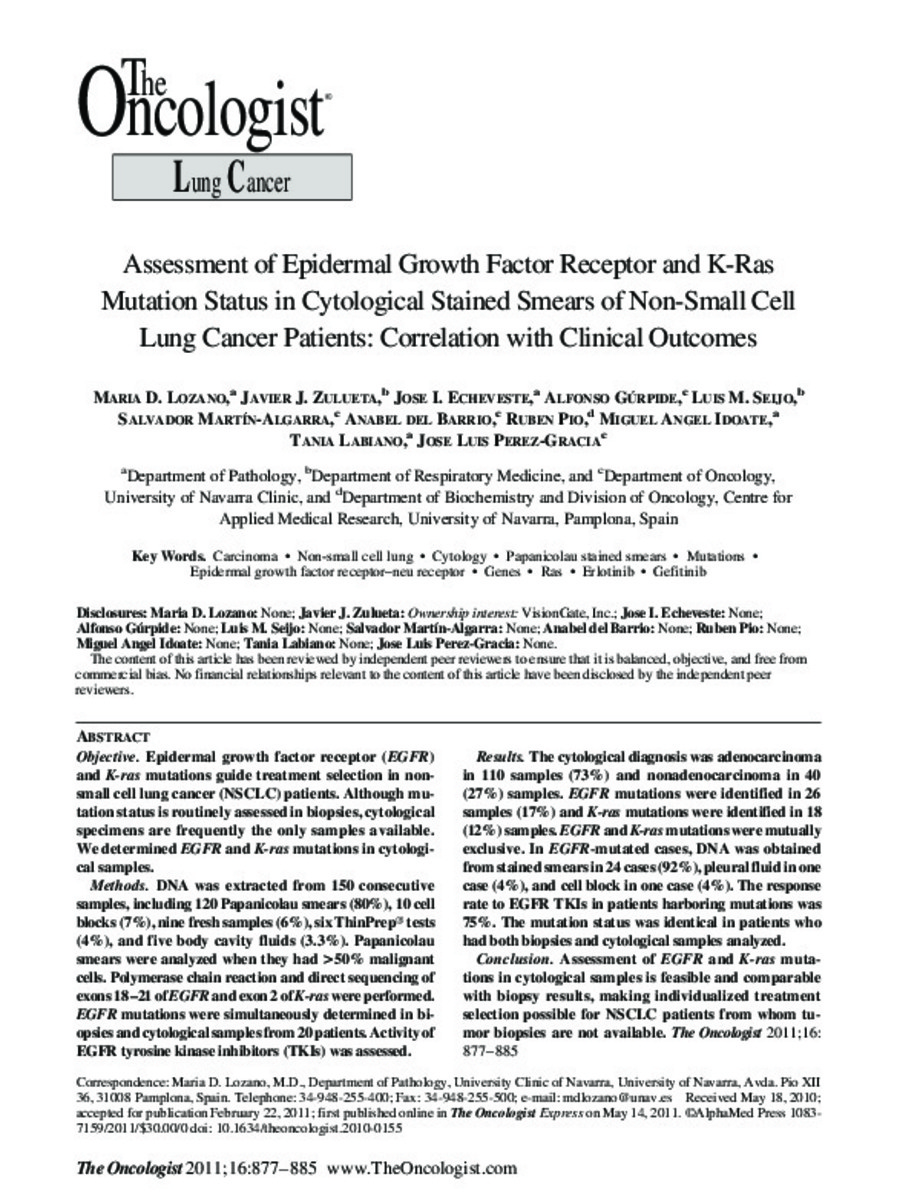Full metadata record
| DC Field | Value | Language |
|---|---|---|
| dc.creator | Lozano, M.D. (María Dolores) | - |
| dc.creator | Zulueta, J. (Javier) | - |
| dc.creator | Echeveste, J.I. (José I.) | - |
| dc.creator | Gurpide, A. (Alfonso) | - |
| dc.creator | Seijo, L. (Luis) | - |
| dc.creator | Martin-Algarra, S. (Salvador) | - |
| dc.creator | Barrio, A. (Anabel) del | - |
| dc.creator | Pio, R. (Rubén) | - |
| dc.creator | Idoate, M.A. (Miguel Ángel) | - |
| dc.creator | Labiano, T. (Tania) | - |
| dc.creator | Perez-Gracia, J.L. (Jose Luis) | - |
| dc.date.accessioned | 2012-10-31T09:44:43Z | - |
| dc.date.available | 2012-10-31T09:44:43Z | - |
| dc.date.issued | 2011 | - |
| dc.identifier.citation | Lozano MD, Zulueta JJ, Echeveste JI, Gurpide A, Seijo LM, Martin-Algarra S, et al. Assessment of epidermal growth factor receptor and K-ras mutation status in cytological stained smears of non-small cell lung cancer patients: correlation with clinical outcomes. Oncologist 2011;16(6):877-885. | es_ES |
| dc.identifier.issn | 1083-7159 | - |
| dc.identifier.uri | https://hdl.handle.net/10171/23549 | - |
| dc.description.abstract | Epidermal growth factor receptor (EGFR) and K-ras mutations guide treatment selection in non-small cell lung cancer (NSCLC) patients. Although mutation status is routinely assessed in biopsies, cytological specimens are frequently the only samples available. We determined EGFR and K-ras mutations in cytological samples. METHODS: DNA was extracted from 150 consecutive samples, including 120 Papanicolau smears (80%), 10 cell blocks (7%), nine fresh samples (6%), six ThinPrep(R) tests (4%), and five body cavity fluids (3.3%). Papanicolau smears were analyzed when they had >50% malignant cells. Polymerase chain reaction and direct sequencing of exons 18-21 of EGFR and exon 2 of K-ras were performed. EGFR mutations were simultaneously determined in biopsies and cytological samples from 20 patients. Activity of EGFR tyrosine kinase inhibitors (TKIs) was assessed. RESULTS: The cytological diagnosis was adenocarcinoma in 110 samples (73%) and nonadenocarcinoma in 40 (27%) samples. EGFR mutations were identified in 26 samples (17%) and K-ras mutations were identified in 18 (12%) samples. EGFR and K-ras mutations were mutually exclusive. In EGFR-mutated cases, DNA was obtained from stained smears in 24 cases (92%), pleural fluid in one case (4%), and cell block in one case (4%). The response rate to EGFR TKIs in patients harboring mutations was 75%. The mutation status was identical in patients who had both biopsies and cytological samples analyzed. CONCLUSION: Assessment of EGFR and K-ras mutations in cytological samples is feasible and comparable with biopsy results, making individualized treatment selection possible for NSCLC patients from whom tumor biopsies are not available. | es_ES |
| dc.language.iso | eng | es_ES |
| dc.publisher | AlphaMed Press | es_ES |
| dc.rights | info:eu-repo/semantics/openAccess | es_ES |
| dc.subject | Adenocarcinoma/drug therapy/genetics | es_ES |
| dc.subject | Antineoplastic Agents/therapeutic use | es_ES |
| dc.subject | Carcinoma, Non-Small-Cell Lung/drug therapy/genetics | es_ES |
| dc.title | Assessment of Epidermal Growth Factor Receptor and K-Ras Mutation Status in Cytological Stained Smears of Non-Small Cell Lung Cancer Patients: Correlation with Clinical Outcomes | es_ES |
| dc.type | info:eu-repo/semantics/article | es_ES |
| dc.relation.publisherversion | http://www.ncbi.nlm.nih.gov/pmc/articles/PMC3228207/pdf/onc877.pdf | es_ES |
| dc.type.driver | info:eu-repo/semantics/article | es_ES |
Files in This Item:
Statistics and impact
Items in Dadun are protected by copyright, with all rights reserved, unless otherwise indicated.






